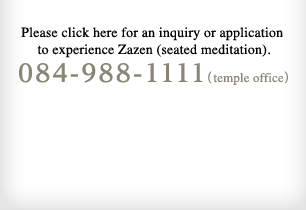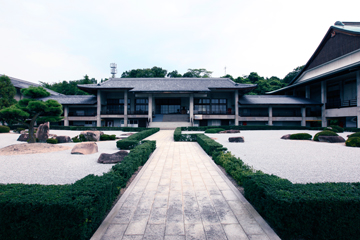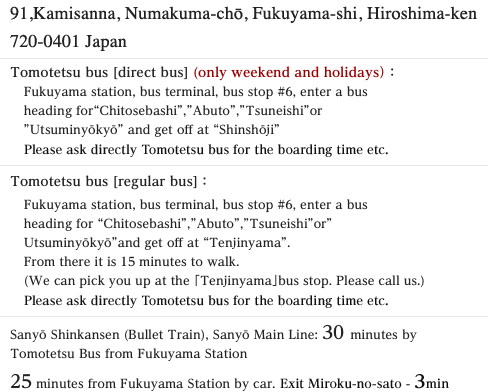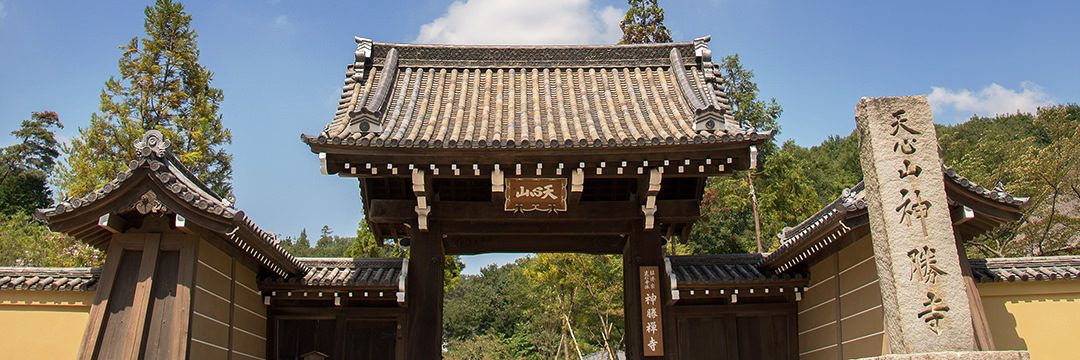

Mt. Tenshin Shinshō-ji (Rinzai sect Kennin-ji school) was completed on December 2nd, 1965 after Master Ekijū Sōshin, the seventh superintendent priest of the Rinzai sect's Kennin-ji school, was invited by the founding patron Kambara Hideo, one of his devoted followers, to build a temple.
Along with being a place for memorial services there are many temples and buildings in the precincts such as the Mumyō-in, the International Zen Training Hall etc. A tea house called Shūro-ken was recreated by the old arrangement plan of the Fushin-an, a famous tea room of the Omotesenke tea school. Shinshō-ji opens the door of Zen and tea ceremony to not only Japan but overseas as well. It is designed as a place for self-examination in the tradition of the Rinzai Zen school to give all people the chance to realize the point of "living right now".
The main statue of this temple is Maitreya Buddha and the name of the temple is taken from the name of the founding patron's father, Kambara Katsutaro.
| Mountain Name | Mt. Tenshin |
|---|---|
| Built | December 2nd, 1965 |
| Main Object of Worship | Miroku Bosatsu |
| Protecting Deity | Miroku-no-sato Tenmangu (a reverence to the Dazaifu Tenjin) |
| Sect and school | Rinzai Zen sect, Kennin-ji school |
| Temple Crest | Plum Basin (Ume bachi) |
- Zen Master Ekijū
(Superintendent Priest of Kyōto Kennin-ji school) - Master Ekijū Sōshin (also known as Kongō Kutsu) was the priest who was asked to found this temple.
His secular name was Tsuchida, which he later changed to Takeda. He was born on July 10th, 1896 on the Kunisaki Peninsula in Oita prefecture and got ordained in Shōsui-ji in Katata/Shiga Prefecture when he was eleven. In May 1915 he started his training in Kennin-ji under Takeda Mokurai Rōshi and continued then with Takeda Eisen Rōshi, from whom he received Dharma transmission.
He was the abbot of Shōsui-ji and Daisen-in and worked then in the Honzan of Daitoku-ji. In 1944 he became the Rōshi of the Kennin-ji sōdō and in 1954 he was appointed to be the seventh superintendent priest of the Kennin-ji sect. In 1965 he became the first abbot of Shinshō-ji and on June 20th 1989 he passed away at the age of 92.
- Kambara Hideo
(Tenshōin Denshaku Gotoku Shūrei Daikoji. Former President of Tsuneishi Holdings Corporation.) - Born on September 1st, 1916 as the oldest son of his father Kambara Katsutaro and mother Hisa. He was sent to war multiple times. In 1939, he graduated from Ritsumeikan University's Law Department. After being discharged from the army, Kambara entered the company run by his father. In 1944 he started to simultaneously serve as the president of Seto Inland Seaship Co., Ltd. (currently Kambara Kisen Co., Ltd.) and the vice president of Tsuneishi Shipbuilding Co., Ltd. In 1955, he became the first mayor of the town Numakuma. After the passing of his father in 1961, he started to work as the president of Tsuneishi Shipbuilding Co., Ltd. On December 2nd, 1965, construction of Shinshō-ji (an authorized religious corporation) was completed with Kambara as the founding patron. On February 16th, 1977, Shinshō-ji Mumyō-in (Hall of Ignorance) was completed and a dedication ceremony was held. However, Kambara was unable to witness this ceremony. He passed away at Kyōto University Hospital on March 12th of the same year. He was sixty years old.
 91,Kamisanna, Numakuma-chō, Fukuyama-shi, Hiroshima-ken 720-0401 Japan
91,Kamisanna, Numakuma-chō, Fukuyama-shi, Hiroshima-ken 720-0401 Japan
Tomotetsu bus (direct bus, only weekend and holidays)
Fukuyama station, bus terminal, bus stop #6, enter a bus heading for 『Miroku no Sato direct bus』 and get off at 「Shinshōji」
Tomotetsu bus (regular bus)
Fukuyama station, bus terminal, bus stop #6, enter a bus heading for 「Chitosebashi」,「Abuto」,「Tsuneishi」or「Utsuminyōkyō」and get off at 「Tenjinyama」. From there it is 15 minutes to walk.(We can pick you up at the 「Tenjinyama」bus stop. Please call us.)
※Please ask directly Tomotetsu bus for the boarding time etc.
084-952-3100
Sanyō Shinkansen (Bullet Train), Sanyō Main Line: 30 minutes by Tomotetsu Bus
25 minutes from Fukuyama Station by car.
Exit Miroku-no-sato - 3min





























